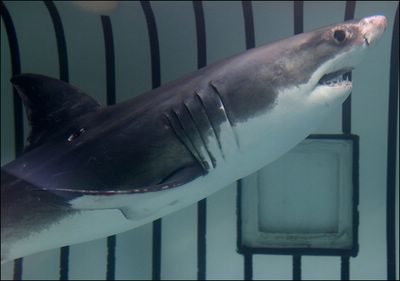Captivity is no way of life for a great white shark

This is an example of a great white shark in captivity.

For the second summer in a row, the Monterey Bay Aquarium has resumed its search for a living great white shark in Santa Monica Bay and adjacent waters. But the search for another shark to display in captivity was marred by the death of a great white in a Malibu shark-holding pen two weekends ago.
The small female shark had been caught by a commercial fisherman off Huntington Beach, and had been held for several days in a small holding tank in San Pedro. Aquarium officials said the shark was transferred to the Malibu pen June 17, but had not eaten and "just ran out of gas" and died two days later.
The death has rekindled the controversy over the program, which last year saw the successful capture and transfer to Monterey of a small shark that spent six months of captivity in a specially designed shark habitat at the Monterey scientific and tourist attraction. That shark was the first great white to have been successfully kept in captivity, and after it became aggressive to other animals in its tank, it was tagged and released to the wild.
Monterey Bay officials were just bringing the floating shark pen up the coast to Malibu and trying to find a yearling shark in coastal waters when this year's first live great white was captured. The Malibu floating pen is used for a several-weeks-long acclimation period and the eventual transfer 300 miles up the coast to the Monterey facility, said aquarium spokesman Ken Peterson.Local commercial fishermen have been asked to call the aquarium crews if they accidentally snag one of the sharks, which are protected from harvest under state law, he said.
The aquarium's scientific research permit allows the fishermen to try to keep sharks alive as they transfer them to the Malibu pen.Peterson said the chain of events that resulted in the shark's death started Monday afternoon off Orange County, when the shark ate a baited hook and was brought aboard a commercial fishing ship.
The shark was transferred to a holding pen in San Pedro, which was too small to feed it in, Peterson said.The decisions about what to do with the captured shark were made more difficult by the fact that its eye was injured at some point. "It was not a responsible thing to do, to release this hunter into the wild before her eye could heal," Peterson said."Our husbandry staff made the call to wait for the pen, which was being brought up the coast to Malibu," he said. By the time the shark was transferred into the 4-million-gallon pen anchored at Paradise Cove, the shark may have been too weak to eat.
The aquarium then found itself defending the death of one of the creatures they are campaigning to save. "We know that when people see living animals up close they get more engaged with them, more emotionally attached to them," said aquarium spokesman Ken Peterson in a telephone interview."You have to see that level of attachment before you can motivate people to take the political action to save these creatures," he continued.
"Sharks are dying by the tens of millions a year worldwide, and the public has to cry out loud to save the sharks."But not this way, said a shark researcher in nearby Santa Cruz. Sean van Sommeran, director of the Pelagic Shark Research Foundation, said he respectfully parts company with the Monterey Bay Aquarium on the issue of displaying large sharks in tanks."They are awesome to look at but they just do not do well in captivity," Sommeran said in a telephone interview.
"Having a white shark in captivity for research and conservation is a big dollar industry," he said. "But this cash cow in terms of a captive animal has just resulted in another shark death."Peterson said i ncreased visitor revenues at the Monterey Bay Aquarium boosted revenues by more than $500,000, which was used to fund shark research in the western Pacific Ocean.
This research, being conducted by Stanford University, includes DNA sampling of sharks to determine genetic diversity and the tagging of sharks that are caught and released off the California coast."We are getting some California tags showing up west of Hawaii," Peterson said. "The wide range of these individual animals was not something we knew."Now that the floating pen has been anchored a mile off the Escondido Creek bridge on Pacific Coast Highway, the aquarium has resumed efforts to find a live great white shark.
This year, in addition to trying to buy one from local fishermen, the aquarium is fishing for baby great white sharks in shallow waters where juveniles have been known to warm themselves off Pacific Palisades, Peterson said.The City Council at its Monday meeting directed city staff to write a letter to the Monterey Bay Aquarium requesting the shark holding pen be relocated away from Malibu.

0 Comments:
Post a Comment
<< Home